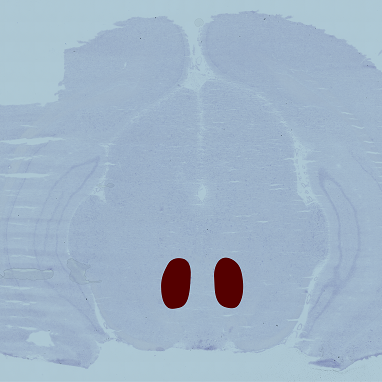Illustration (click to hide):

Project Description
Initiation of alcohol and nicotine use in early age is a well-known risk factor for the development of addiction. The glutamatergic system plays an important role in mediating the reinforcing effects of addictive drugs and its dysfunction has been associated with addiction. The glutamatergic phenotype can be identified by the expression of the Vesicular Glutamate Transporters (Vgluts) 1, 2, and 3, which are the focus of our research [1, 2]. The present study aims to localize and quantify the effect of alcohol and/or nicotine exposure on Vgluts in the mesocorticolimbic brain of adolescents. Regions of interest are the ventral tegmental area, nucleus accumbens, prefrontal cortex, dorsal striatum, hippocampus, and amygdala; all key regions in the addiction neurocircuitry. Expression of Vglut1-3 in the brain of adolescent male rodents is assessed using in situ hybridization with DIG-labelled RNA probes on cryosections and visualized using a brightfield microscope. Cell counting and localization are performed using CellProfiler. Adolescence is a period during which the initial contact with alcohol and nicotine commonly occurs, while the brain is developing. Prevention and treatment of alcohol and nicotine use disorders can be improved by identifying early neuromolecular signatures of alcohol and nicotine on the brain.
References
- Comasco, E., J. Hallman, and A. Wallen-Mackenzie, Haplotype-tag single nucleotide polymorphism analysis of the vesicular glutamate transporter (VGLUT) genes in severely alcoholic women.Psychiatry Res, 2014. 219(2): p. 403-5.
- Vrettou, M., et al., Ethanol affects limbic and striatal presynaptic glutamatergic and DNA methylation gene expression in outbred rats exposed to early-life stress.Addict Biol, 2017. 22(2): p. 369-380.
Tags: Microscopy, model organisms and tissues
Project Information
-
BIIF Principal Investigators
- Petter Ranefall
External Authors
Erika Comasco, Maria Vrettou, SciLifeLab, Department of Neuroscience, Uppsala University; Ingrid Nylander, Department of Pharmaceutical Biosciences, Uppsala University -
Date
2018-02-16 🠚 2019-10-09